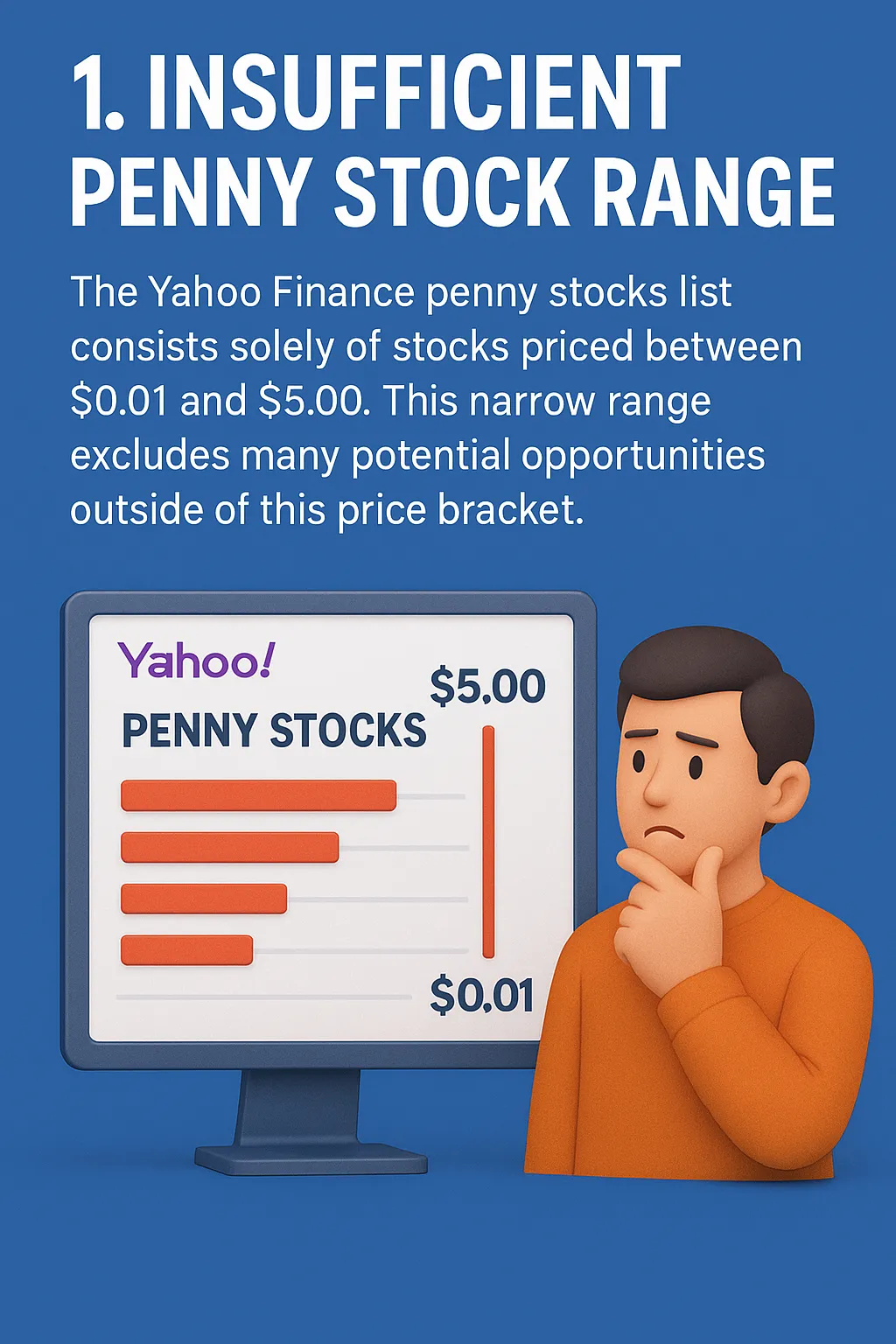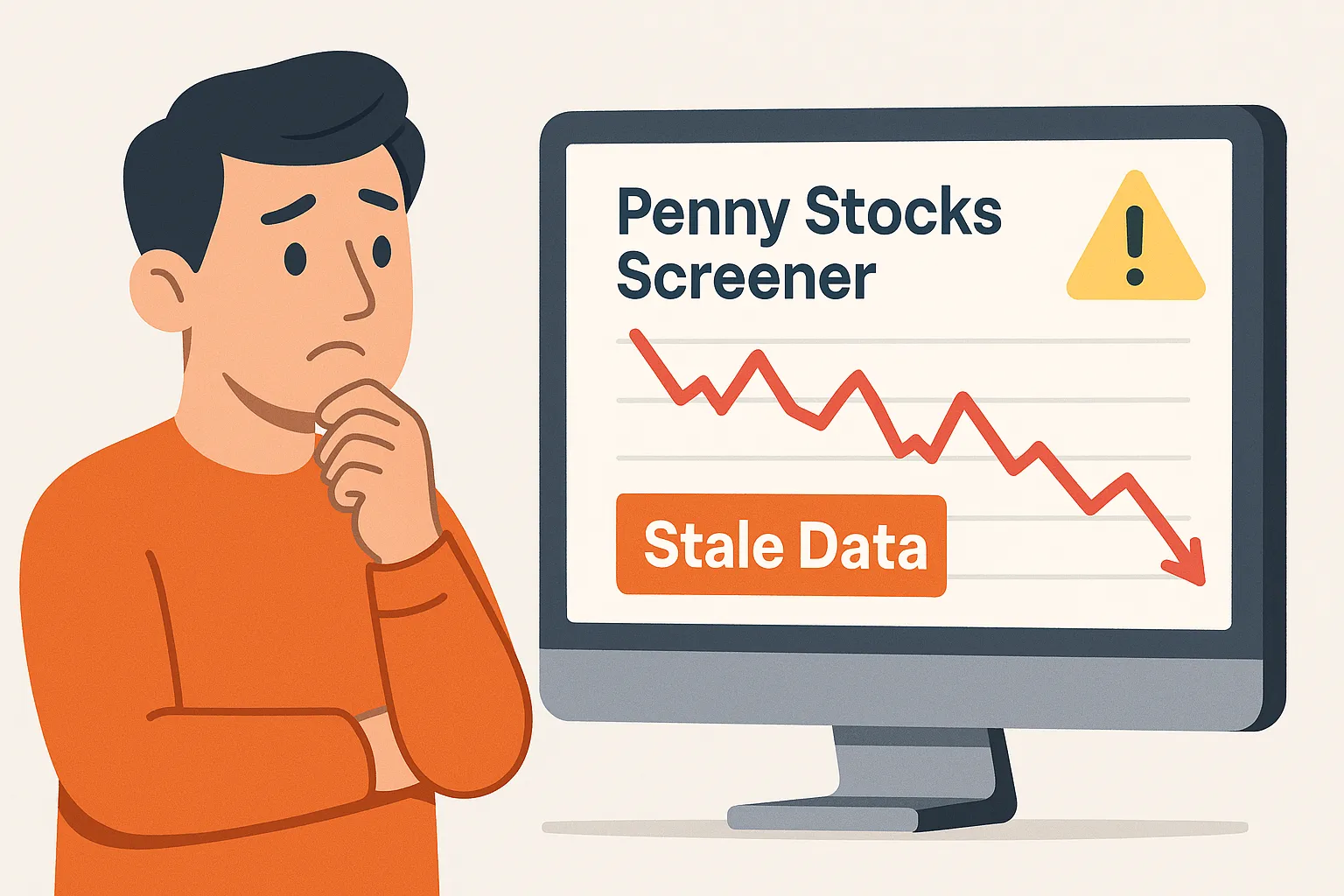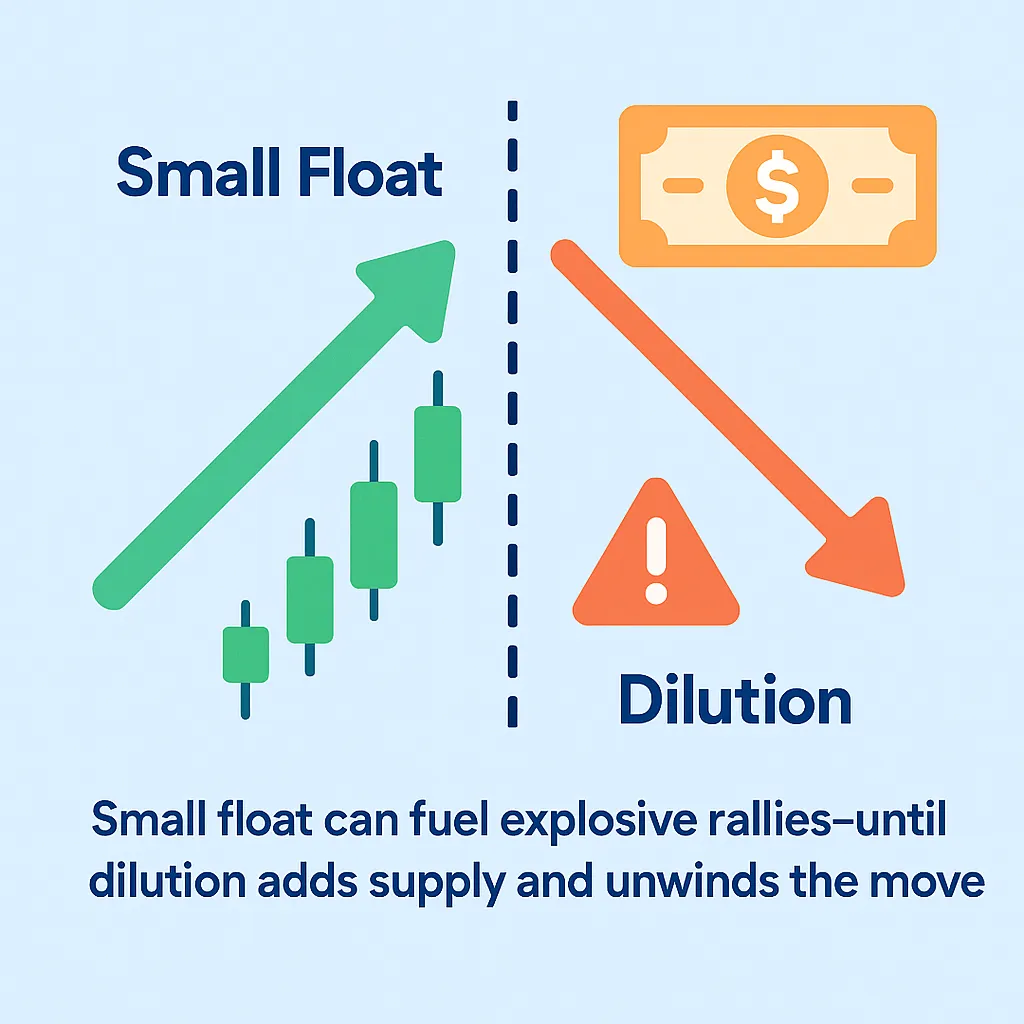
5 Dangerous Flaws in Yahoo Finance Penny Stocks Screener You Must Avoid
5 Dangerous Flaws in Yahoo Finance penny stocks screener You Must Avoid
Last updated: September 17, 2025 • 12–15 min read
🔎 Quick Take (open me)
The Yahoo Finance penny stocks screener is popular because it’s free and familiar—but relying on it for fast-moving, thinly traded names can create blind spots that cost real money. In this review, you’ll learn the five most dangerous flaws (from liquidity traps to stale filters), how to fix them, and which workflow helps you build a higher-signal watchlist for most active penny stocks. We’ll also compare alternatives and show you how to pair screeners with real alerts so you don’t chase noise.
If you’ve ever scanned a Yahoo Finance penny stocks list at 9:25 AM and thought, “There’s my winner,” only to watch spreads widen and volume vanish at the open—you’re not alone. Free tools attract crowds, and crowds attract traps. This penny stock screener review explains where those traps come from and the simple, evidence-based ways to avoid them. We’ll cover data timing, float/liquidity blind spots, filter pitfalls, survivorship bias, and false “most active” signals. You’ll also get a practical framework for Yahoo Finance penny stock analysis that fits real intraday decision-making.
- Spot the 5 critical flaws that can mislead you before you place a trade.
- Turn generic “most active” scans into actionable premarket/first-hour watchlists.
- Add safeguards: float, dilution risk, spread control, and volume continuity checks.
- Compare tools and choose the best penny stock alerts alternative for your style.
This article focuses on the Yahoo Finance penny stocks screener available at Yahoo Finance (Most Active Penny Stocks). We’re not dismissing free tools—they’re great for learning and idea surfacing—but we’ll show why you must layer additional checks to avoid costly mistakes. Finally, we’ll compare popular options and outline a practical, alert-driven workflow that many traders find more reliable than simply chasing a generic “most active” board.
By the end, you’ll know exactly when a screener is helpful, when it’s harmful, and how to turn simple public data into a confident, rules-based process. Bookmark this if you actively trade small-caps or you’re exploring a best penny stock alerts alternative that complements (not replaces) fast due diligence.
Ready? In the next section we’ll start with the biggest misconception: why “most active” doesn’t automatically mean “tradable”—and how to quantify the difference so you’re not caught in a liquidity mirage at the opening bell.
⚠️ Flaw #1 – “Most Active” ≠ Tradable Liquidity
The most obvious entry point into the Yahoo Finance penny stocks screener is its Most Active Penny Stocks page. At first glance, this looks like a goldmine: tickers sorted by daily volume, highlighting where traders are rushing in. But here’s the problem—“most active” in terms of raw shares traded doesn’t always equal tradable liquidity.
For example, a stock might trade 50 million shares in a session, yet each trade is just a few cents wide. With spreads ballooning, fills become unpredictable. Many new traders confuse high share turnover with liquidity, but real liquidity requires consistent depth at each price level. Without that, you’re left with a mirage—lots of shares traded, but no safe entry or exit without heavy slippage.
“Volume is vanity if the bid–ask spread is chaos.”
📊 Why This Matters
- Thin depth: You see 50M shares traded but only a few thousand shares sitting at the top levels of the order book.
- Slippage risk: Market orders jump several cents or even dimes, wiping out your setup.
- False comfort: “Most active” suggests safety in numbers, but the crowd piles into fragile moves that collapse fast.
The penny stock screener review shows that Yahoo Finance doesn’t provide Level 2 order book data or liquidity depth analysis. This blind spot encourages overconfidence in volume-based rankings. If you’re using their “most active penny stocks” as your signal, you may be chasing unstable trades that evaporate by the time you hit buy.

✅ Better Approach
Always confirm depth and continuity. A genuine liquid penny stock has tight spreads, consistent bids, and sustained interest over multiple sessions. Combine raw volume with float checks, news catalysts, and intraday chart behavior. A free screener can surface tickers, but only disciplined analysis makes them tradeable.
For a structured way to balance volume, catalysts, and risk controls, see our guide on Fundamentals of Stock Market Investing. It explains why liquidity and fundamentals must work together—even in penny stocks.
In Block 3, we’ll tackle Flaw #2—how Yahoo’s delayed or stale filters during the opening bell can steer you into trades that are already over.
⚠️ Flaw #2 – Stale or Delayed Filters During the Open
One of the biggest weaknesses in the Yahoo Finance penny stocks screener is timing. The prebuilt filters update on a lag—sometimes several minutes after the market open. In penny stocks, those minutes are everything. A ticker that looked promising at 9:31 can already be exhausted by 9:35.
Traders relying on a delayed Yahoo Finance penny stocks list often end up chasing momentum that has already peaked. By the time the screener refreshes, spreads widen, catalysts fade, and the “most active penny stocks” are no longer offering safe entries. This lag introduces a structural disadvantage compared to traders using real-time tools or dedicated alert systems.
“In penny stocks, seconds are strategy—delays are death.”
📊 Impact of Screener Delays
- Missed catalysts: News-based spikes often fade in less than 5 minutes.
- Late entries: You’re buying after a parabolic move when risk is highest.
- Broken setups: Charts already rolled over by the time your scan updates.
A good penny stock screener review doesn’t just list flaws—it offers fixes. The solution here is pairing screeners with live news feeds and direct broker data. When combined, you can filter potential trades instantly and validate them with depth and catalyst checks. Yahoo Finance, by contrast, leaves you exposed to stale data.

✅ Better Approach
To counteract delays, prioritize tools with live updates. Many pros rely on broker-native scanners or API-driven feeds that adjust instantly as volume spikes. Even if you use Yahoo Finance for broad scans, confirm timing with real-time watchlists or alerts. That way, you avoid buying into the tail end of already exhausted momentum.
Want to see how alerts integrate into timing strategy? Check out our Day Trading Mentor guide, where we walk through practical examples of early entry timing.
🚀 Take Control of Timing
Don’t let delayed filters sabotage your trades. Set up real-time alerts and structured watchlists with TradeStockAlerts resources. Staying early—not late—is how small wins stack into consistent profits.
In Block 4, we’ll look at Flaw #3—how ignoring float and dilution risks in the Yahoo screener can turn a “cheap” opportunity into a slow-motion disaster.
⚠️ Flaw #3 – Float & Dilution Blind Spots
The Yahoo Finance penny stocks screener can surface tickers with eye-catching percentage moves, but it offers limited insight into effective float and dilution pathways (e.g., at-the-market offerings, warrants, convertible notes). A stock with “micro float” can run hard on little supply—until the company taps an ATM or files a registration that expands outstanding shares. This is where many traders get trapped: a clean chart plus “most active penny stocks” ranking looks bullish, but a fresh issuance collapses the trend.
A robust penny stock screener review should emphasize that float is not static. The headline float number often ignores locked insider holdings, recent filings, or shelf registrations. Your workflow needs checks beyond a basic Yahoo Finance penny stocks list: recent S-1/S-3 activity, ATM agreements, and historical patterns of raising capital after spikes.
“If price action is the story, float and dilution are the plot twists.”
🔍 What to Verify Before Trading
- Effective Float: Adjust the quoted float for insider/institutional locks and recent unlock events.
- Dilution Triggers: Check for open shelf registrations (S-3), newly effective registration statements, or active ATMs.
- Offerings After Spikes: Review the company’s history of raising capital immediately after big green days.
- Warrant Overhang: Deep in-the-money warrants can cap upside or accelerate selling on rallies.

✅ A Practical Checklist (Use Every Time)
- Baseline float & shares out: Note the reported float and total shares outstanding; flag inconsistencies.
- Recent filings scan: Look for S-1/S-3, 424B, or 8-K financing updates in the last 30–60 days.
- ATM/warrants: Identify price levels where dilution becomes attractive (ATM price bands, warrant strike zones).
- Liquidity sanity check: Pair float with true tradable liquidity (tight spreads, steady depth, continuity of volume).
- Risk rules: Wider stops & smaller size on micro-float names; demand confirmation before adding.
🧩 Where Yahoo’s Screener Falls Short (and How to Patch It)
The Yahoo Finance penny stocks screener doesn’t surface dilution mechanics or warrant overhang by default. Patch this gap by combining it with a filings reader and a catalyst tracker. Treat the screener as a lead list, not a green light. Your edge comes from verifying supply mechanics before momentum traps you.
Market Basics
Build context for float, liquidity, and micro-cap behavior.
Swing Trading Books
Curated reads that sharpen risk control and trade selection.
What Is Float?
Primer on shares available for public trading and why it matters.
EDGAR Filings Search
Find S-1/S-3, 424B, and 8-K financing updates quickly.
Next, we’ll compress Flaw #4 (spread/slippage ignored in rankings) and Flaw #5 (survivorship bias & ticker churn) so you can see how they interact with float. Together, these three risks explain why “most active” alone can be dangerously incomplete.
⚠️ Flaw #4 – Spread/Slippage Ignored in Rankings
Rankings that emphasize volume and % change but ignore effective spread and impact cost create hidden losses. Backtest your setups using mid-price entries and exits, then stress-test with the normal spread observed during your trading window (e.g., +2–5 ticks). If your edge disappears after accounting for spread, size down or skip.
- Use limit orders near liquidity pools; avoid market orders on thin tapes.
- Track VWAP deviation and spread as part of your “go/no-go” checklist.
- Prefer names with repeatable liquidity patterns across sessions.
⚠️ Flaw #5 – Survivorship Bias & Ticker Churn
The Yahoo Finance penny stocks list you see today reflects tickers that survived to be visible—many others were delisted or reverse-split into obscurity. This bias can overstate opportunity. Archive your screens, track churn, and evaluate whether your thesis relies on a few outliers or a broad, repeatable base of names.
- Maintain a “graveyard” log of delisted/RS tickers to understand life cycles.
- Score screeners not just on hits but on the rate of permanent attrition.
- Require catalysts with real follow-through, not just one-day noise.
🛠 A Better Workflow for Penny Stock Screening
After reviewing five dangerous flaws in the Yahoo Finance penny stocks screener, it’s clear the tool should only be a starting point. To turn noise into signal, you need a workflow that blends scans with catalysts, float checks, liquidity validation, and alerts. That’s how you avoid being misled by a stale Yahoo Finance penny stocks list or “most active penny stocks” mirages.
- Scan broad: Use Yahoo Finance screener to surface volume names quickly.
- Filter smart: Cross-check float, dilution, and filings (EDGAR/S-3/ATM agreements).
- Confirm live: Validate spreads, depth, and catalysts with real-time broker data.
- Build watchlists: Group names into A/B tiers by liquidity and catalyst quality.
- Set alerts: Use real-time alerts instead of waiting for lagged updates.
The best traders don’t just chase “top lists”—they engineer a repeatable system. That’s where an alert-driven workflow is stronger than a one-dimensional penny stock screener review.
🔄 Alternatives & The Best Penny Stock Alerts Approach
Instead of depending solely on Yahoo, consider pairing it with alternatives or dedicated alert services. A best penny stock alerts alternative offers speed, catalyst integration, and proactive risk signals. These tools are not just “lists” but dynamic systems that respond to breaking events.
📈 Penny Stocks Watch List
Curated names updated with catalysts and liquidity checks.
⚡ Alerts Beyond Stocks
Learn how alerts extend to crypto and high-volatility assets.
By combining scanners with structured alerts, you keep the discovery benefits of Yahoo’s free screener while patching its speed and depth flaws. That balance is how pros turn raw scans into real trading edges.
📌 Mini Case Study – From Scan to Trade Plan
Imagine spotting a ticker on the Yahoo Finance penny stocks screener at 9:28 AM. It shows 10M shares premarket volume, up 25%. A beginner might prepare to chase. A disciplined trader will:
- Check filings: finds an S-3 effective last week (dilution risk ✅).
- Check float: only 12M effective shares, but ATM agreement filed (supply risk ✅).
- Check depth: bid-ask spread already widened 10 cents on small size (liquidity risk ✅).
Result: Skip the chase, wait for confirmation, or size smaller. The trader turns what could’ve been a trap into a preserved account balance. That’s the value of combining Yahoo Finance penny stock analysis with structured alerts.
❓ FAQs on the Yahoo Finance Penny Stocks Screener
1. Is the Yahoo Finance penny stocks screener reliable?
Reliable for broad discovery, but limited by stale data and lack of float/dilution context. Use it as a first filter, not your only signal.
2. How often does the screener update?
Updates are delayed compared to broker-native platforms. Critical moves at the open may not appear until several minutes later.
3. Does it show float and dilution risk?
No. The screener lists volume, price change, and other surface metrics but lacks deeper corporate action data.
4. What’s the best penny stock alerts alternative?
Services that combine news catalysts, float checks, and real-time alerts—like curated watchlists and mentoring resources—offer stronger coverage.
5. Should beginners use Yahoo Finance penny stocks list?
Yes, but carefully. Beginners should treat it as a learning tool, not a trade execution engine. Always confirm with real-time data before acting.
✅ Conclusion & Next Steps
The Yahoo Finance penny stocks screener is a free, accessible tool—but it comes with dangerous blind spots. We’ve unpacked five critical flaws: liquidity mirages, delayed filters, float/dilution gaps, spread/slippage risks, and survivorship bias. On their own, these issues can drain accounts. Combined, they form a roadmap for smarter trading—if you know what to avoid.
The solution isn’t abandoning screeners altogether—it’s layering them with alerts, filings checks, and risk rules. That’s how you turn raw data into a durable edge. If you’re ready to take the next step, explore our internal resources and start building a structured alert-driven workflow today.
🚀 Next Step: Build Your Edge
Learn more in our Day Trading Mentor program or grab a free starter guide with Stock Market for Dummies PDF. The fastest path forward is replacing lagging screeners with real-time alerts and structured trade plans.